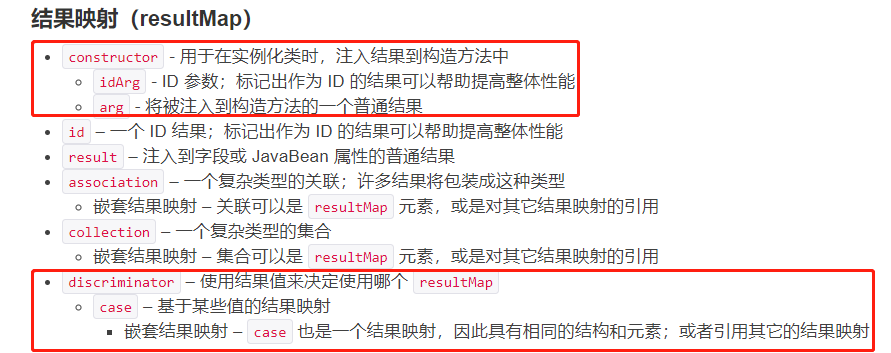 MyBatis实现复杂环境的Sql查询
MyBatis实现复杂环境的Sql查询
作者:鱼仔
博客首页: codeease.top (opens new window)
公众号:神秘的鱼仔
在前面的学习中,我们差不多把Mybatis的基本增删改查、配置文件的配置都讲解了一遍,但是在实际的开发中我们编写的sql不会那么简单,今天就来模拟复杂环境的Sql查询
# (一)resultMap结果映射
resultMap 元素是 MyBatis 中最重要最强大的元素,我们之前所写的sql语句,返回值都是简单的基本数据类型或者某一个实体类,比如下面这段sql返回的就是最简单的User类型。
<select id="getUserById" resultType="com.javayz.pojo.User" parameterType="int">
select * from user where id=#{id};
</select>
2
3
现在思考一下下面这种情况,如果实体类中定义的某一个字段和数据库中的字段不一致怎么办
public class User {
private int id;
private String lastname;
//.....
}
2
3
4
5
比如我定义了一个User类,包含id和lastname两个属性,而数据库中这两个字段的名字为id和name。此时再执行查询时结果如下:lastname这个字段直接为null

这时候我们就可以使用resultMap来解决这个问题,resultMap可以讲数据库中的字段映射到实体类上。column代表数据库中的字段名,properties代表实体类中的字段名,通过映射之后Mybatis就可以找到对应的字段。
<resultMap id="UserMap" type="User">
<!--column代表数据库中的字段名,properties代表实体类中的字段名-->
<result column="id" property="id"/>
<result column="name" property="lastname"/>
</resultMap>
<select id="getUserById" resultMap="UserMap" parameterType="int">
select id,name from user where id=#{id};
</select>
2
3
4
5
6
7
8
9
ResultMap 的设计思想是,对简单的语句做到零配置,对于复杂一点的语句,只需要描述语句之间的关系就行了。
# (二)复杂环境下的resultMap使用
在实际的应用场景中,我们会遇到很多比较复杂的业务逻辑,这里resultMap的优势才会被放大。因此我们通过一个案例来实现复杂环境的查询。
//创建教室表
create table classroom
(
id int not null AUTO_INCREMENT,
classname VARCHAR(40) not null,
PRIMARY KEY (id)
)
//创建学生表
create table student
(
id int not null AUTO_INCREMENT,
name VARCHAR(40) not null,
classid int not null,
PRIMARY KEY (id),
FOREIGN key (classid) REFERENCES classroom(id)
)
//创建一些数据
insert into classroom VALUES (1,'101班')
insert into classroom VALUES (2,'102班')
insert into student VALUES(1,'Amy',1);
insert into student VALUES(2,'Bob',1);
insert into student VALUES(3,'javayz',1);
2
3
4
5
6
7
8
9
10
11
12
13
14
15
16
17
18
19
20
21
22
在Java的实体类代码中分别建立Student和ClassRoom的类
public class Student {
private int id;
private String name;
private ClassRoom classRoom;
//省略构造方法、get、set、toString
//务必给出无参构造方法
}
2
3
4
5
6
7
ClassRoom 类
public class ClassRoom {
private int id;
private String classname;
//省略构造方法、get、set、toString
//务必给出无参构造方法
}
2
3
4
5
6
# 2.1 多对一查询(association)
多对一查询在上面这个案例中表现为多个学生在一个教实中,因此这里的Student类中的第三个变量我们设置为ClassRoom类。
现在我们通过两种方式进行多对一查询:
在mapper路径下创建StudentMapper和studentMapper.xml
其中StudentMapper接口定义一个查询方法:
public interface StudentMapper {
List<Student> selectAllStudent();
}
2
3
查询方法一:通过类似嵌套子查询的方式查询:
<select id="selectAllStudent" resultMap="StudentAndClassRoom">
select * from student
</select>
<resultMap id="StudentAndClassRoom" type="Student">
<result property="id" column="id"/>
<result property="name" column="name"/>
<!--对于复杂类型,对象使用association处理,集合使用collection-->
<association property="classRoom" column="classid" javaType="ClassRoom" select="getClassRoom">
</association>
</resultMap>
<select id="getClassRoom" resultType="ClassRoom">
select * from classroom where id = #{classid}
</select>
2
3
4
5
6
7
8
9
10
11
12
13
首先通过 select * from student 语句查询到所有数据,返回类型通过resultMap进行映射,id和name字段属于基本数据类型字段不需要改动,由于classRoom是一个对象方法,因此需要用association 进行处理,实体类中的属性名为classRoom,与Student表进行连接的字段是classid,Java类是ClassRoom,通过这几个属性,继续使用select查询。
所以上面一段代码总结下来就是两句话:
1、查询student表。
2、通过查询出来的classid值查询classRoom表。
通过测试类测试结果:
@Test
public void testSelect(){
SqlSession sqlSession = MybatisUtils.getSqlSession();
StudentMapper mapper = sqlSession.getMapper(StudentMapper.class);
List<Student> students = mapper.selectAllStudent();
System.out.println(students);
}
2
3
4
5
6
7
结果如下:
[Student{id=1, name='Amy', classRoom=ClassRoom{id=1, classname='101班'}},
Student{id=2, name='Bob', classRoom=ClassRoom{id=1, classname='101班'}},
Student{id=3, name='javayz', classRoom=ClassRoom{id=1, classname='101班'}}]
2
3
查询方法二:结果嵌套查询
<select id="selectAllStudent" resultMap="StudentAndClassRoom">
select s.id sid,s.name sname,c.id cid,c.classname cname
from student s,classroom c
where s.classid=c.id
</select>
<resultMap id="StudentAndClassRoom" type="Student">
<result property="id" column="sid"/>
<result property="name" column="sname"/>
<association property="classRoom" javaType="ClassRoom">
<result property="id" column="cid"/>
<result property="classname" column="cname"/>
</association>
</resultMap>
2
3
4
5
6
7
8
9
10
11
12
13
我个人比较喜欢结果嵌套查询,所有的sql语句写在select语句中,根据结果要返回的值在resultMap中填写对应的数据。
结果与第一种方式相同。
# 2.2 一对多查询(collection)
修改一下之前的两个实体类,来实现一对多的查询,每个教室里有多个学生:
public class Student {
private int id;
private String name;
private int classId;
//省略get、set、toString方法
//务必给出无参构造方法
}
2
3
4
5
6
7
public class ClassRoom {
private int id;
private String classname;
private List<Student> students;
//省略get、set、toString方法
//务必给出无参构造方法
}
2
3
4
5
6
7
接着编写Mapper接口和对应的Mapper.xml
public interface ClassRoomMapper {
List<ClassRoom> getClassRoomByid(@Param("id") int id);
}
2
3
在这里我只介绍结果嵌套查询的方式。先通过sql查询出字段信息,再通过resultMap进行展示。
<?xml version="1.0" encoding="UTF8" ?>
<!DOCTYPE mapper
PUBLIC "-//mybatis.org//DTD Mapper 3.0//EN"
"http://mybatis.org/dtd/mybatis-3-mapper.dtd">
<mapper namespace="com.javayz.mapper.ClassRoomMapper">
<select id="getClassRoomByid" resultMap="ClassRoomAndStudent" parameterType="int">
select c.id cid,c.classname cname,s.id sid,s.name sname,s.classid classid
from student s,classroom c
where s.classid=c.id and c.id=#{id}
</select>
<resultMap id="ClassRoomAndStudent" type="ClassRoom">
<result property="id" column="cid"/>
<result property="classname" column="cname"/>
<!--对于集合属性,需要使用collection来实现-->
<collection property="students" ofType="Student">
<result property="id" column="sid"/>
<result property="name" column="sname"/>
<result property="classId" column="classid"/>
</collection>
</resultMap>
</mapper>
2
3
4
5
6
7
8
9
10
11
12
13
14
15
16
17
18
19
20
21
需要注意几个点,对于集合属性,我们需要使用collection。这里的集合属性中用到了ofType字段,该字段表示集合泛型中所使用的泛型对象类型。
# (三)总结
到这里为止,Mybatis的各种查询以及配置用法都讲完了,对于复杂类型,注意以下几点:
1、对象的关联使用association,集合的关联使用collection。
2、官网的resultMap中还有两个参数没有使用:

首先讲一下constructor ,constructor主要是用来配置构造方法,默认情况下mybatis会调用实体类的无参构造方法创建一个实体类,如果在实体类中配置了有参构造方法而没有配无参构造,就会报错,此时可用constructor 注入构造方法。
discriminator 鉴别器,可以通过case的值来决定使用哪个resultMap。
